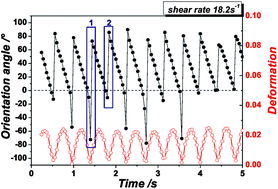Deformation and orientation dynamics of polysiloxane microcapsules in linear shear flow†
Abstract
In this publication we examined the deformation, the orientation, the surface Young's moduli and the bursting process of different types of polysiloxane microcapsules. It turned out that the rheological properties of these particles were very much influenced by the amount of


 Please wait while we load your content...
Please wait while we load your content...